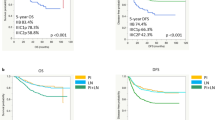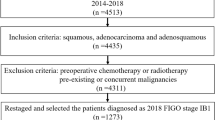Abstract
Objective
The aim of this retrospective analysis is to reveal clinicopathological findings and clinical outcome of patients with stage IB1/IB2 (FIGO 2018) uterine cervical cancer.
Methods
Based on the database of the Japanese Gynecologic Oncology Group, 2194 patients with stage IB1/IB2 (FIGO 2018), who underwent radical hysterectomy between 1/1/2004–12/31/2008, were identified as eligible for this retrospective study.
Results
Patients with squamous cell carcinoma had significantly frequent lympho-vascular space invasion than those with non-squamous cell carcinoma in both stage IB1 and IB2 (stage IB1; 29.1% vs. 17.1%, p < 0.0001, stage IB2; 50.5% vs. 39.7%, p = 0.0009). Among 1262 patients with stage IB1, 61.2% (772/1262) were low-risk group, 29.4% (371/1262) were intermediate-risk group (single risk: 23.3%, double risks: 6.1%). Of 932 patients with stage IB2, 32.1% (299/932) were low-risk group, 59.1% (551/932) were intermediate-risk group (single intermediate-risk: 31.0%, double intermediate-risk: 28.1%). Disease-free survival rate and overall survival rate of stage IB1 patients were significantly better than those with stage IB2 (5-year DFS; 94.7% vs. 88.6%, p < 0.001, 5-yrs OS; 98.5% vs. 95.1%, p < 0.001). Stage IB1 Patients with double intermediate-risk showed significantly worse survival than those with single intermediate-risk (5-yrs DFS: 96.1% vs. 84.6%, p < 0.001, 5-yrs OS: 98.9% vs. 93.0%, p = 0.029). Multivariate analysis revealed that double intermediate-risk was the independent prognostic factor in stage IB1, but non-squamous cell carcinoma and intermediate-risk in stage IB2.
Conclusion
Non-squamous cell carcinoma and intermediate-risk decreased survival in patients with stage IB2, whereas double intermediate-risk was a negative impact on survival in stage IB1.


Similar content being viewed by others
References
Arbyn M, Weiderpass E, Bruni L et al (2020) Estimates of incidence and mortality of cervical cancer in 2018: a worldwide analysis. Lancet Glob Health 8(2):e191–e203
Yaegashi N (2020) Gynecologic cancer comittee report in 2018. Acta Obstet Gynaecol Jpn 72:800–856
NCCN Clinical Practice Guidelines in Oncology (NCCN Guidelines) Cervical Cancer version 1.2020. https://www.nccn.org/professionals/physician_gls/pdf/cervical_blocks.pdf. Accessed 27 Mar 2021
Keys HM, Bundy BN, Stehman FB et al (1999) Cisplatin, radiation, and adjuvant hysterectomy compared with radiation and adjuvant hysterectomy for bulky stage IB cervical carcinoma. N Engl J Med 340(15):1154–1161
Whitney CW, Sause W, Bundy BN et al (1999) Randomized comparison of fluorouracil plus cisplatin versus hydroxyurea as an adjunct to radiation therapy in stage IIB-IVA carcinoma of the cervix with negative para-aortic lymph nodes: a Gynecologic Oncology Group and Southwest Oncology Group study. J Clin Oncol 17(5):1339–1348
Rose PG, Bundy BN, Watkins EB et al (1999) Concurrent cisplatin-based radiotherapy and chemotherapy for locally advanced cervical cancer. N Engl J Med 340(15):1144–1153
Ebina Y, Mikami M, Nagase S et al (2019) Japan Society of Gynecologic Oncology guidelines 2017 for the treatment of uterine cervical cancer. Int J Clin Oncol 24(1):1–19
Bhatla N, Aoki D, Sharma DN et al (2018) Cancer of the cervix uteri. Int J Gynaecol Obstet 143(Suppl 2):22–36
Matsuo K, Machida H, Mandelbaum RS et al (2019) Validation of the 2018 FIGO cervical cancer staging system. Gynecol Oncol 152(1):87–93
de Gregorio A, Widschwendter P, Ebner F et al (2020) Influence of the new FIGO classification for cervical cancer on patient survival: a retrospective analysis of 265 histologically confirmed cases with FIGO stages IA to IIB. Oncology 98(2):91–97
Yan DD, Tang Q, Tu YQ et al (2019) A comprehensive analysis of the factors of positive pelvic lymph nodes on survival of cervical cancer patients with 2018 FIGO stage IIIC1p. Cancer Manag Res 11:4223–4230
Oncology FCOG (2014) FIGO staging for carcinoma of the vulva, cervix, and corpus uteri. Int J Gynaecol Obstet 125(2):97–98
Melamed A, Margul DJ, Chen L et al (2018) Survival after minimally invasive radical hysterectomy for early-stage cervical cancer. NEngl J Med 379(20):1905–1914
Kato T, Takashima A, Kasamatsu T et al (2015) Clinical tumor diameter and prognosis of patients with FIGO stage IB1 cervical cancer (JCOG0806-A). Gynecol Oncol 137(1):34–39
Ramirez PT, Frumovitz M, Pareja R et al (2018) Minimally invasive versus abdominal radical hysterectomy for cervical cancer. NEngl J Med 379(20):1895–1904
Galic V, Herzog TJ, Lewin SN et al (2012) Prognostic significance of adenocarcinoma histology in women with cervical cancer. Gynecol Oncol 125(2):287–291
Katanyoo K, Sanguanrungsirikul S, Manusirivithaya S (2012) Comparison of treatment outcomes between squamous cell carcinoma and adenocarcinoma in locally advanced cervical cancer. Gynecol Oncol 125(2):292–296
Irie T, Kigawa J, Minagawa Y et al (2000) Prognosis and clinicopathological characteristics of Ib-IIb adenocarcinoma of the uterine cervix in patients who have had radical hysterectomy. Eur J Surg Oncol 26(5):464–467
Shimada M, Nishimura R, Nogawa T et al (2013) Comparison of the outcome between cervical adenocarcinoma and squamous cell carcinoma patients with adjuvant radiotherapy following radical surgery: SGSG/TGCU Intergroup Surveillance. Mol Clin Oncol 1(4):780–784
Ishii K, Hosaka N, Toki T et al (1998) A new view of the so-called adenoma malignum of the uterine cervix. Virchows Arch 432(4):315–322
Mikami Y, Kiyokawa T, Hata S et al (2004) Gastrointestinal immunophenotype in adenocarcinomas of the uterine cervix and related glandular lesions: a possible link between lobular endocervical glandular hyperplasia/pyloric gland metaplasia and “adenoma malignum.” Mod Pathol 17(8):962–972
Kojima A, Mikami Y, Sudo T et al (2007) Gastric morphology and immunophenotype predict poor outcome in mucinous adenocarcinoma of the uterine cervix. Am J Surg Pathol 31(5):664–672
Kurman RJ, International Agency for Research on Cancer, and World Health Organization (2014) WHO classification of tumours of female reproductive organs, 4th edn. World Health Organization classification of tumours. International Agency for Research on Cancer, Lyon
Mikami Y (2020) Gastric-type mucinous carcinoma of the cervix and its precursors—historical overview. Histopathology 76(1):102–111
Kusanagi Y, Kojima A, Mikami Y et al (2010) Absence of high-risk human papillomavirus (HPV) detection in endocervical adenocarcinoma with gastric morphology and phenotype. Am J Pathol 177(5):2169–2175
Houghton O, Jamison J, Wilson R et al (2010) p16 Immunoreactivity in unusual types of cervical adenocarcinoma does not reflect human papillomavirus infection. Histopathology 57(3):342–350
Park KJ, Kiyokawa T, Soslow RA et al (2011) Unusual endocervical adenocarcinomas: an immunohistochemical analysis with molecular detection of human papillomavirus. Am J Surg Pathol 35(5):633–646
Karamurzin YS, Kiyokawa T, Parkash V et al (2015) Gastric-type endocervical adenocarcinoma: an aggressive tumor with unusual metastatic patterns and poor prognosis. Am J Surg Pathol 39(11):1449–1457
Kojima A, Shimada M, Mikami Y et al (2018) Chemoresistance of gastric-type mucinous carcinoma of the uterine cervix: a study of the sankai gynecology study group. Int J Gynecol Cancer 28(1):99–106
Nishio S, Mikami Y, Tokunaga H et al (2019) Analysis of gastric-type mucinous carcinoma of the uterine cervix—an aggressive tumor with a poor prognosis: a multi-institutional study. Gynecol Oncol 153(1):13–19
Matsuo K, Shimada M, Yamaguchi S et al (2019) Association of radical hysterectomy surgical volume and survival for early-stage cervical cancer. Obstet Gynecol 133(6):1086–1098
Holl K, Nowakowski AM, Powell N et al (2015) Human papillomavirus prevalence and type-distribution in cervical glandular neoplasias: results from a European multinational epidemiological study. Int J Cancer 137(12):2858–2868
Acknowledgements
The authors thank all JGOG institution participated in this study and JGOG Cervical Cancer Committee members for management of this study
Author information
Authors and Affiliations
Corresponding author
Ethics declarations
Conflict of interest
None declared.
Additional information
Publisher's Note
Springer Nature remains neutral with regard to jurisdictional claims in published maps and institutional affiliations.
About this article
Cite this article
Tsuji, K., Shimada, M., Takahashi, F. et al. Clinico-pathological characteristics of patients with stage IB1–IB2 (FIGO 2018) uterine cervical cancer: a nationwide study in Japan. Int J Clin Oncol 26, 1541–1552 (2021). https://doi.org/10.1007/s10147-021-01938-4
Received:
Accepted:
Published:
Issue Date:
DOI: https://doi.org/10.1007/s10147-021-01938-4




